Beijing, May 28: India on Saturday launched its second IT corridor in China to cash in on the burgeoning Chinese software market which remained elusive despite the presence of top Indian technology firms.
The National Association of Software and Services Companies (NASSCOM) has established one more Digital Collaborative Opportunities Plaza (SIDCOP) platform in China in an effort to provide market access to Indian IT firms in the huge Chinese market, the NASSCOM said.
Agreements worth RMB 36 million (about USD six million) were signed between Indian service providers and Chinese customers at the launch of the corridor by China's Guiyang Municipal government and the NASSCOM, a NASSCOM official said.
The pilot projects launched on the SIDCOP platform would be executed over the next year, a NASSCOM statement said.
Last December, the NASSCOM established its first SIDCOP platform in the Chinese port city of Dalian, which is India's first IT hub in China.
India's top IT firms have a big presence in China, specially multi-nationals and IT Corridor at Dalian which are expected to provide a gateway for the Indian IT-small and medium-sized enterprises. The Dalian IT corridor was formally launched few days ago.
While Dalian corridor's focus was on IOT (Internet of Things), the Guiyang corridor will focus on Big Data, Gagan Sabharwal, Senior Director, Global Trade Development NASSCOM said. The platform in Guiyang intends to create online and offline presence to promote a "co-create culture" between two large neighbours in the Big Data space, he said.
Speaking at the launch of the Guiyang IT corridor, India's Ambassador to China Gautam Bambawale said the corridor which visualises collaboration between member companies of the NASSCOM and the Guiyang city authorities is aimed at setting up local offices and assisting companies from Guiyang to establish software and IT units in India.
An Indian company named 'Zeta-V' will establish an Artificial Intelligence enabled platform for SIDCOP to bring together the IT requirements of Chinese companies, particularly in Guiyang, and Indian companies which have solutions to offer, Bambawale said.
"In this way, we will be marrying together the requirements of Chinese companies with the capabilities of Indian IT service providers. We visualise that these initiatives will give a big impetus to cooperation between India and China in the IT-enabled services sector," he said.
Referring to last month's informal summit between Prime Minister Narendra Modi and Chinese President Xi Jinping, the envoy said, "India-China relations are progressing well, particularly after the Informal Summit".
"The two leaders decided to meet at an informal summit so that they could have candid, free and open discussions with each other aimed at enhancing strategic communication between them," he said.
The two leaders spoke with each other for almost 10 hours at Wuhan and discussed their goals and objectives for their countries, how they viewed the fast-changing international situation and in this context how they would like to see India-China bilateral ties developing over the coming months.
"As a result of these unprecedented discussions between the leaders of India and China, they were able to reach consensus on over-arching and strategic issues. It is now left for the rest of us to take their vision forward," he said.
"As a result of the successful talks between President Xi and Prime Minister Modi at Wuhan, we now have a political environment in which India-China business and commercial ties can expand rapidly," he said
For India, getting access to China's IT market, valued at over USD 493 billion in 2013 by the Ministry of Industry and Information Technology of China, is important to address the massive trade deficit which has now spiralled to over USD 51 billion. The Chinese IT market grew exponentially since then.
India has been demanding China to provide market access to Indian IT and pharmaceutical firms for several years to reduce bilateral trade deficit.
The two corridors, which were started in collaboration with China's provincial governments, are expected to provide the much-needed big opening for Indian IT firms, Sabharwal said.
Considering the potential, Bambawale made a strong case for Indian IT presence in China. "As you all know, India is a world leader in the area of Information Technology and IT enabled services with annual revenue of over USD 164 billion and exports of over USD 120 billion," he said in his address.
"Our IT companies have a presence in more than 70 countries in the world, generating employment for up to 12 million people worldwide. In China, Indian IT companies are present in 10 cities around the country, with a total work-force of around 25,000 employees. However, we believe that the potential for Indian companies to cooperate with China is huge and needs more work and efforts," he said.
Sabharwal said in addition to the Dalian and Guiyang, the NASSCOM is in touch with four other provinces including Wuhan to work out new IT corridors based on local needs. He said negotiations were on with some of the Chinese firms to sign up with big Indian IT firms.
"If that works out it could provide a big opening," he said.






Comments
Add new comment